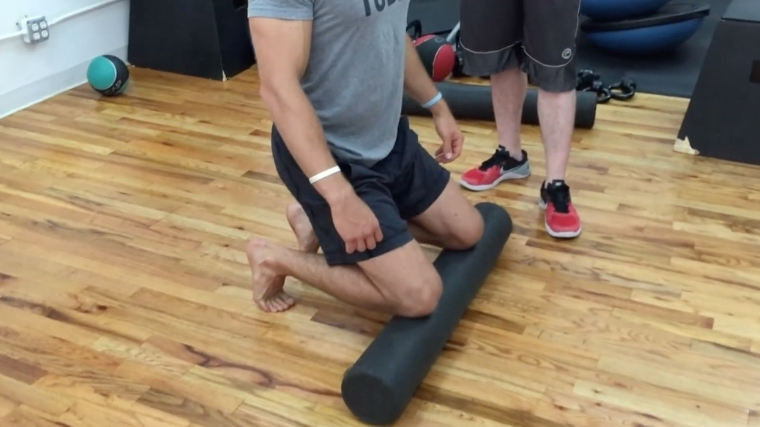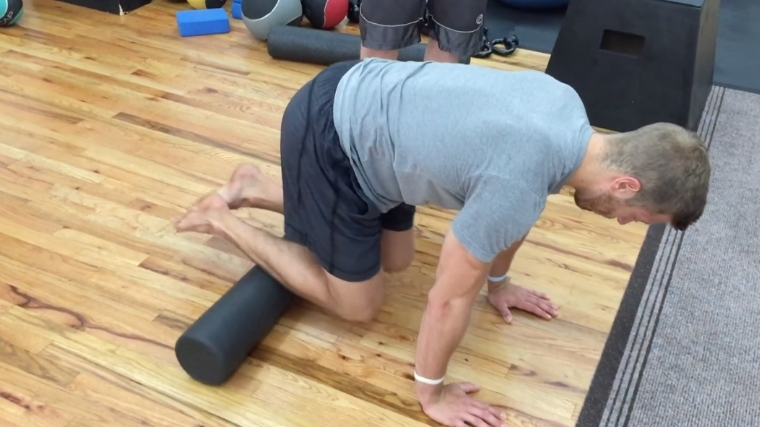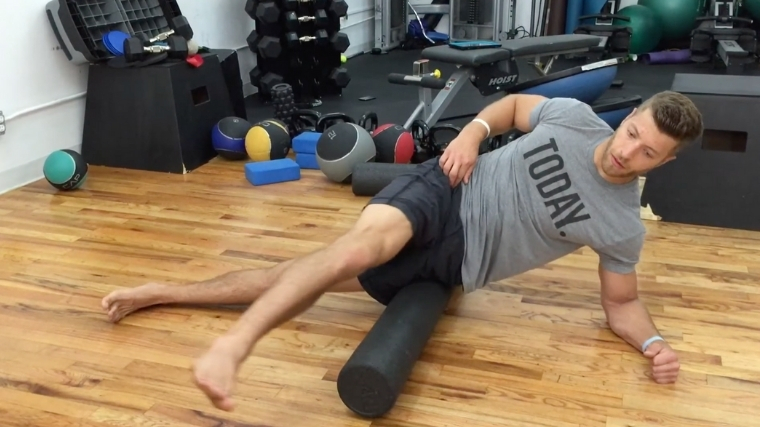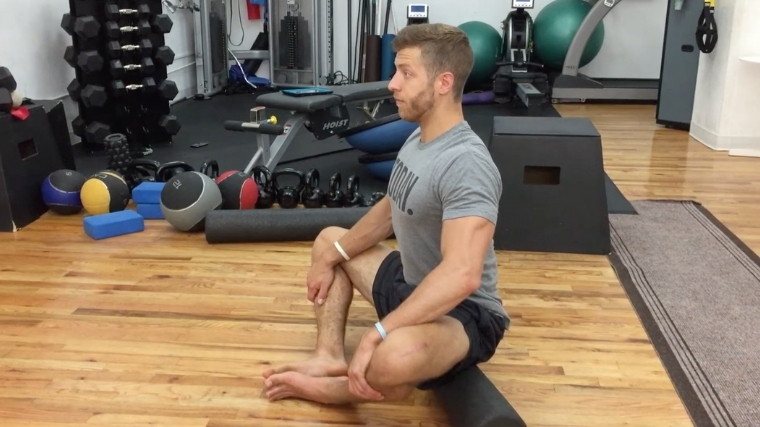You sit for six and a half hours each day (statistically speaking, that is), and it’s doing you no favors in the gym. (1) Whether you sit for work, while you binge Netflix, or to read a book, it’s affecting your gym performance. Your muscle fascia — a web-like system of collagen and tissue that wraps around your muscles — muscles tighten as you sit. In the case of muscles and performance, if you don’t use it, you lose it.
Enter foam rolling, a popular myofascial release method among athletes and the general population, to help reduce post-exercise muscle soreness and improve mobility. It’s not enough to roll your muscles out. You want to combine rolling with a movement that engages both your muscles and joints. Below are eight exercises that do just that. You can do each one separately, though we do suggest doing all eight in a row before your next leg day.
Best Foam Roller Exercises
- Kneeling Calf Stretch
- Mobile Shin Roll
- Lateral Shin Roll
- Lying Leg Sweep
- Hip Flexor Swing
- Assisted Butterfly
- Extended/Assisted Hamstring Stretch
- Hip Flexor Roll
Editor’s note: The content on BarBend is meant to be informative in nature, but it shouldn’t take the place of advice and/or supervision from a medical professional. The opinions and articles on this site are not intended for use as diagnosis, prevention, and/or treatment of health problems. Speak with your physician if you have any concerns.
Best Foam Roller Exercises For Your Legs — Video
In the video below, former BarBend Training Editor Jake Boly demonstrates the best foam roller exercises for your legs with the help of Matt Moskowitz, head of training at Hell’s Kitchen Wellness.
Kneeling Calf Stretch
The kneeling calf stretch focuses on the anterior tibialis. This muscle plays an important role in ankle mobility and being able to squat and deadlift with good technique. If you lack dorsiflexion, your heels may come off the ground while squatting, and then you can achieve a full range of motion. Releasing the anterior tibialis will free up your ankle mobility so you can squat deeper and run more smoothly.
The Benefits of the Kneeling Calf Stretch
- It will lead to deeper squats.
- Improves ankle dorsiflexion and overall ankle mobility.
How to Do the Kneeling Calf Stretch
Begin by kneeling on the foam roller. From this kneeling position, flex the toes to create tension in the calf muscles. Lean back and sit onto the heels while maintaining an upright posture. Hold this for 30 seconds in a position where you feel an active stretch without pain.
Mobile Shin Roll
After releasing shin tightness with the kneeling calf stretch, foam rolling the shins will bring important blood flow to this area. As your roll your shins, you’ll discover sore and tight spots. Focus on those areas to improve ankle dorsiflexion and reduce the chances of getting shin splints. But be warned, this roll doesn’t tickle. Let pain be your guide in how much pressure you apply to your shins.
The Benefits of the Mobile Shin Roll
- It brings blood flow to the shin to improve ankle dorsiflexion and reduce your chances of getting shin splints.
- This exercises helps to improve your range of motion and performance with squat and deadlift variations.
How to Do the Mobile Shin Roll
Kneel on all fours to create a tabletop position with your shins on the roller. And like the mountain climber exercise, maintain this tabletop position and begin to roll the foam roller up and down your lower leg. Do this for 30 seconds or 30 repetitions.
Lateral Shin Roll
The ankle needs stability to resist side-to-side movement when squatting, deadlifting, and during many other leg movements. Rolling this area from side to side with the lateral mobile shin roll helps relax and release the your calf muscles to help improve stability and relieve tightness. This may help to prevent ankle sprains or shin splints if your sport involves running.
Benefits of the Lateral Shin Roll
- It massages neglected parts of the calf muscle as most trainees only massage the front and back parts of the calf.
- This is a great exercise for athletes who are in danger of getting shin splints.
How to Do the Lateral Shin Roll
Maintain the previous tabletop position and roll technique, except roll with a slight hip shift to the right and left side, alternating sides each time. The goal is to hit each side equally, so it’s recommended to keep a flow to this rolling method, as demonstrated in the video. Repeat this rolling technique for 30 seconds or 30 repetitions.
Lying Hip Sweep
Most leg exercises require hip flexion and hip extension — this movements makes a near-perfect warm-up exercise because it does both. With one hip pinned on the foam roller ensures your non-working hip is not swinging side to side, emphasizing the working leg.
Benefits of the Lying Hip Sweep
- The foam roller gives you feedback to make sure you’re using good technique when sweeping the leg back and forth.
- Trains hip flexion and extension at the same time.
How to Do the Lying Hip Sweep
Get into a side plank position with a foam roller positioned under your hips perpendicularly. Maintain a straight line from your head to your toes. Sweep your top leg forward and backward, slowly, allowing it to trace only as far as feels comfortable. Repeat this movement for 30 seconds or 30 repetitions on both sides.
Hip Flexor Swing
Hip flexor strength is as important as hip mobility, and this simple movement will warm up your hip flexors for the work ahead. The act of bringing the knee across your body and back also trains hip internal and external rotation, which are important factors for getting into good squat and deadlift positions. A lack of hip internal rotation is one of the causes of hip impingement.
Benefits of the Hip Flexor Swing
- Trains hip flexion along with hip rotation.
- It makes you aware of any mobility differences between sides.
How to Do the Hip Flexor Swing
Lay back-down on a foam roller positioned perpendicularly under your rib cage. Extend your legs and then bend one knee 90 degrees and slowly swing it over your other leg. Bring that leg back to the center, and reverse sides. Repeat this movement for 30 seconds or 30 repetitions.
Assisted Butterfly
Healthy adductors are necessary for optimal hip extension. They also help keep the knees in line with the toes during squats, especially at the bottom of a squat. So, it pays to not only strengthen them but stretch them too for improved hip mobility and recovery. The assisted butterfly allows you to stretch the adductors while receiving feedback for better posture comfortably.
Benefits of the Assisted Butterfly
- Actively stretches the adductors to improve mobility and recovery.
- Improving the flexibility and mobility of the adductors may prevent groin strains. (2)
How to Do the Assisted Butterfly
Sit on the edge of the foam roller, the tailbone just off the roller. Assume a butterfly position with feet together. Maintain good posture, keeping the chest up and shoulders down. The arms work to pull the legs out, opening the groin. Hold this stretch for 30 seconds to a minute while taking deep breaths.
Extended/Assisted Hamstring Stretch
Stretching the hamstrings before training is a hotly debated topic, but stretching them post-training will start the recovery process and help improve hamstring flexibility. Using the foam roller and a towel ensures a better hamstring stretch as you actively control the stretch by using your ankles, the towel, or both. Be careful not to stretch into pain, as this negates the benefits of this stretch.
Benefits of the Extended/Assisted Hamstring Stretch
- It helps to improve recovery (and maybe reduce soreness) after performing squats and deadlifts.
- Improved hamstring flexibility assists with better posture and knee stability.
How to Do the Hamstring Stretch
From the seated position, roll the foam roller down your leg under the calves. Then extend the legs and flex their toes towards your body. This will stretch and lengthen the hamstrings. For a heightened stretch, bring the foam roller closer towards the knee. Aim to maintain good posture while holding this stretch.
How to Do the Assisted Hamstring Stretch
In the same position as above, wrap a towel around your feet and pull the toes towards your body to stretch and lengthen the hamstring. The harder you pull on the towel, the bigger the stretch. Hold each stretch for 30 seconds to a minute.
Hip Flexor Roll
The hip flexor’s mobility plays a key role with squatting and deadlifting because they’re needed for full hip extension. Mobile hip flexors allow you to run, jump, squat deep and help strengthen your legs through a longer range of motion. And there is no better way to prepare and improve their mobility for training than by foaming rolling them. Spending time on this area will improve your lower body training.
Benefits of the Hip Flexor Roll
- It brings blood flow to the hip flexors to improve hip mobility.
- Foaming rolling the hip flexors will help promote better movement of the hip, leg, knee, and ankle, helping to reduce your chances of injury.
How to Roll the Hip Flexors
Put the end of the roller underneath one hip with your other leg on the ground with the knee bent and elbows. Roll back and forth over the top of your hip, push with your elbows, and be careful not to roll over your pelvis. Pause on any tender spots and take a few deep breaths to help release muscular tension. Do 10 rolls or 30 seconds on each hip as part of your warm-up.
Understanding the Lower Leg (Anterior Side)
The front of the leg has multiple smaller muscles that run along the tibia and fibula. These muscles can limit ankle flexion and extension along with tight calves, which will impact movements further up the kinetic chain. Below are a few of the anterior (plus posterior) leg muscles we’re focusing on.
- Tibialis Anterior
- Fibularis Longus
- Extensor Digitorum Longus
- Fibularis Brevis
- Gastrocnemius
- Soleus
Related: Need additional calf work? Here’s a quick foam rolling sequence to loosen and mobilize tight calves.
Understanding the Upper Leg (Quadriceps Side)
Spending all day seated can leave the quadriceps and hip flexors feeling tight and overextended. Rolling out the quads and hips together drive healing blood flow to the area and release tension to help improve hip mobility and knee extension. Below are a few of the leg muscles hit in this rolling sequence.
- Vastus Medialis
- Rectus Femoris
- Intermedius
- Vastus Lateralis
- Tensor Fascia Latae
- Sartorius
Understanding the Lower Leg (Hamstring Side)
Because when we sit in a flexed seated position, the hamstring muscles become inactive, which causes them to shorten and tighten. Therefore, they’re important to foam roll to get you ready for the work ahead. Below are the hamstring muscles we’ll be hitting in the sequence’s post-workout final stretches.
- Biceps Femoris (long and short head)
- Semitendinosus
- Semimembranosus
Related: Don’t forget to roll out the hips with the legs. Check out this guide for effectively mobilizing your hips.
Three Ways to Use the Foam Roller
Foam rollers are best used for warm-ups, cool downs, or between sets of strength exercises. Here are the benefits of each.
Warm-Up
If you are inactive, foam rolling will bring blood flow to inactive muscles, reduce muscle stiffness, and help you mentally prepare for the training ahead.
Between Sets of Exercises
When you’re performing a strength exercise that requires mobility, rolling the working muscles may help you recover better between sets. For example, rolling your hips after a squat.
Cool Down
Foam rolling after training will not stop you from getting sore. However, bringing healing blood flow to the working muscles will help reduce soreness and bring your heart rate down.
The Benefits of Using the Foam Roller
Not only do they hurt so good before and after training, but foam also rolling has a few other important benefits, including:
Reducing Muscle Soreness
In a study published by the Journal of Athletic Training, men who foam rolled their legs after a workout reported a decrease in their post-workout tenderness. They used a roller for 20 minutes after their workout, and again 24 and 48 hours later. (3)
Improves Joint Range of Motion
When reducing muscle adhesions in the fascia, you’ll improve the muscles’ elasticity and help them return to their ideal length. This allows the joint to go through a greater range of motion before you train, helping you strengthen all parts of the movement.
Helps With Pain
Self-myofascial release (SMR) on a foam roll can help ease muscular pain and tension. However, it’s important to remember to avoid pain by putting your body in uncomfortable positions while rolling. If it is more than muscle pain, then it’s a signal it is too much. (4)
More Foam Roller Training Tips
Now that you have a handle on the best foam rolling exercises to improve mobility and reduce muscular soreness, you can also check out these other helpful foam rolling articles for strength, power, and fitness athletes.
References
- Yang L, Cao C, Kantor ED, et al. Trends in Sedentary Behavior Among the US Population, 2001-2016. JAMA. 2019;321(16):1587–1597. doi:10.1001/jama.2019.3636
- Tyler TF, et al. The association of hip strength and flexibility with the incidence of adductor muscle strains in professional ice hockey players. Am J Sports Med. 2001 Mar-Apr;29(2):124-8.
- Gregory E P Pearcey et al. Foam rolling for delayed-onset muscle soreness and recovery of dynamic performance measures. J Athl Train. 2015 Jan;50(1):5-13. doi: 10.4085/1062-6050-50.1.01. Epub 2014 Nov 21
- Aynollah Naderi 1, Mohammad Hossein Rezvani 1, Hans Degens 2 Foam Rolling and Muscle and Joint Proprioception After Exercise-Induced Muscle Damage. J Athl Train 2020 Jan;55(1):58-64. doi: 10.4085/1062-6050-459-18. Epub 2019 Dec 19.






